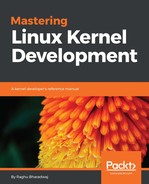Book Description
Explore Implementation of core kernel subsystems
About This Book
- Master the design, components, and structures of core kernel subsystems
- Explore kernel programming interfaces and related algorithms under the hood
- Completely updated material for the 4.12.10 kernel
Who This Book Is For
If you are a kernel programmer with a knowledge of kernel APIs and are looking to build a comprehensive understanding, and eager to explore the implementation, of kernel subsystems, this book is for you. It sets out to unravel the underlying details of kernel APIs and data structures, piercing through the complex kernel layers and gives you the edge you need to take your skills to the next level.
What You Will Learn
- Comprehend processes and fles - the core abstraction mechanisms of the Linux kernel that promote effective simplification and dynamism
- Decipher process scheduling and understand effective capacity utilization under general and real-time dispositions
- Simplify and learn more about process communication techniques through signals and IPC mechanisms
- Capture the rudiments of memory by grasping the key concepts and principles of physical and virtual memory management
- Take a sharp and precise look at all the key aspects of interrupt management and the clock subsystem
- Understand concurrent execution on SMP platforms through kernel synchronization and locking techniques
In Detail
Mastering Linux Kernel Development looks at the Linux kernel, its internal arrangement and design, and various core subsystems, helping you to gain significant understanding of this open source marvel. You will look at how the Linux kernel, which possesses a kind of collective intelligence thanks to its scores of contributors, remains so elegant owing to its great design.
This book also looks at all the key kernel code, core data structures, functions, and macros, giving you a comprehensive foundation of the implementation details of the kernel's core services and mechanisms. You will also look at the Linux kernel as well-designed software, which gives us insights into software design in general that are easily scalable yet fundamentally strong and safe.
By the end of this book, you will have considerable understanding of and appreciation for the Linux kernel.
Style and approach
Each chapter begins with the basic conceptual know-how for a subsystem and extends into the details of its implementation. We use appropriate code excerpts of critical routines and data structures for subsystems.
